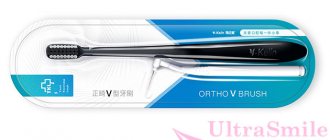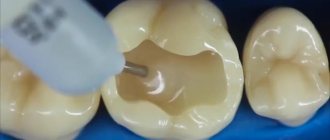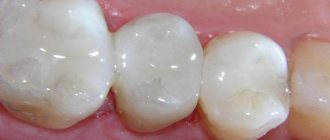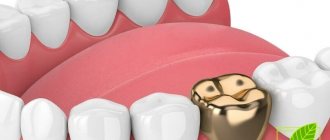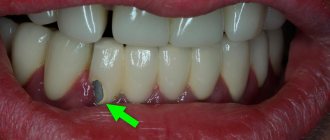Crown care
Artificial teeth are not prone to decay and are not susceptible to carious damage. However, if there is no care for teeth with crowns, plaque forms on the surface and an unpleasant odor appears. These factors contribute to the formation of tartar, which, in turn, provokes serious dental problems.
Caring for ceramic crowns is simple; usually the whole procedure comes down to daily preventative cleaning of teeth and installed structures. It is not necessary to go to a dental clinic for this.
Why do you need to clean bridges?
Dental bridge care must be thorough and regular. But there is no need to worry about having to carry out any complex manipulations. Everything here is quite simple and familiar, because all people have been able to brush their teeth since childhood. We’ll dwell on how to clean dental bridges a little lower, but for now let’s look at why this is necessary:
- for long-term preservation of aesthetics: cleaning helps to remove food pigments in a timely manner, prevents stone (hard deposits) from accumulating on the surface of the prosthesis and under it,
- to reduce the risk of caries and gingivitis: with adequate care, all potentially dangerous foci are removed from soft mucous membranes, from hard dental tissues under supporting teeth and in interdental spaces - food plaque, stuck pieces,
- to extend the life of the denture: the absence of infection around the supporting teeth allows them to last longer. And if hygiene is neglected, cervical caries or root caries often occurs - the tooth can simply break and fall out along with the bridge.
Don't know what type of prosthetics to choose?
We will help in the selection, advise where to read more information and compare types of prosthetics.
Consultation with an orthopedic doctor in Moscow clinics is free! Call now or request a call
Working hours: from 9:00 to 21:00 - seven days a week
How to care for crowns
If we consider the situation as a whole, proper care of crowns is no different from the prevention of all dental diseases. However, professionals recommend following the following rules:
- Hygienic cleaning of teeth and installed structures twice a day. To do this, it is better to use pastes with a minimum abrasiveness coefficient so as not to damage the enamel and soft tissues.
- Carefully remove food debris from the interdental space. An irrigator copes with this task perfectly.
- Rinse your mouth after every meal. To do this, you can use special compounds or just warm water.
- Watch your diet. If crowns are installed, it is better to avoid eating nuts, crackers, etc.
- Control food temperature. Too hot tea or ice-cold lemonade can cause cracking of the relatively fragile cermets.
Dentists recommend massage for crown care. Such structures create increased pressure on the gums, so it is important to stimulate blood circulation in the soft tissues. The massage is performed with smooth, circular movements along and counterclockwise.
Rules of conduct after installing crowns
There are several rules that you can follow to keep your mouth healthy:
- Brush your teeth twice a day – immediately after waking up and before going to bed.
- Rinse your mouth if possible after every meal. This will get rid of food debris and slow down plaque formation.
- Thoroughly clean areas where plaque and food may accumulate. We are talking about the space under the hinged crown of the bridge. To do this, you can use an irrigator, brushes and other devices.
- You should avoid eating too hard foods and chewing on non-food items. Nail chewing, nuts, candy chewing – all of these should be avoided to maximize the life of your crowns.
- You should reduce your consumption of coffee, black tea, red wine, and other coloring foods.
- Gum care is also a very important attribute of healthy teeth. Rinsing and careful attention to the condition of soft tissues are required.
- Cleaning your tongue is a very useful activity. Plaque also accumulates here and must be removed.
Careful care will help maintain health and maximize the service life of any restorations.
Seeing a doctor
You need to make an appointment with a dentist if the following problems occur:
- The installed structure has lost stability;
- There is an unpleasant odor from the mouth;
- An inflammatory process is observed on the gums, pain is felt;
- The crown is installed incorrectly, causes discomfort to the person, and interferes with other teeth;
- The prosthesis fell out.
In addition, you need to visit the clinic for professional preventive cleaning and crown replacement. The service life of such structures varies between 2-15 years, depending on the material of manufacture and compliance with operating rules. Even if the service life of the crown has not expired, it is better to replace it if the color changes or cracks appear. Do not self-medicate, it is better to consult a specialist!
Toothbrush and how to use it correctly
You can choose any toothbrush for fixed bridges. But only of medium hardness, otherwise the bristles simply won’t cope with plaque. However, there are exceptions, for example, the ultra-soft brush from Curaprox (“Curaprox”) - its bristles are located very tightly to each other and do a good job of cleansing.
The brush should be changed every 3-4 months. You also need to purchase a new brush immediately after dentures or after undergoing professional oral hygiene at the dentist. Because germs have accumulated on something that has already been used (even for a couple of weeks).
It is necessary to clean dental bridges in the morning (before or after breakfast) and in the evening before going to bed - that is, the usual hygiene for 2 minutes, 2 times a day. You need to use a brush according to the same principle as with natural teeth. First, moisten the tool with water, apply a pea of paste and position the brush head at an angle of 45 degrees to the teeth. Cleaning vertical surfaces is carried out with sweeping movements from the gums to the cutting edge. On the upper jaw we “sweep out” plaque and food debris, moving from top to bottom, and on the lower jaw, on the contrary, from bottom to top. When all surfaces from the cheeks, lips, tongue and palate are cleaned, then we move on to the horizontal planes (chewing surfaces) - they are cleaned with back and forth movements.
After brushing, rinse your mouth with clean water or mouthwash. Also, after brushing with a regular brush, you can use a mono-beam brush (without paste) to clean the interdental spaces. But a double-sided brush for removable dentures will not work here - it will be inconvenient to use.
The benefits of an irrigator when caring for zirconium crowns
The irrigator is ideal for caring for zirconium crowns and dental structures. The operating principle of the irrigator is based on a directed pulse of water with adjustable intensity. Such equipment massages the gums and effectively cleans the interdental space. Unlike dental floss, it is impossible to damage soft tissues with an irrigator; there is absolutely no discomfort during such treatment.
You can purchase the irrigator in a stationary or portable version. The second option is slightly inferior in terms of water capacity, but you can take the device with you and care for your oral cavity while traveling.
Author of the article
Metal-ceramic dentures
Metal-ceramic dentures are dental crowns consisting of a metal frame and a ceramic coating. This design looks quite natural and lasts a long time, so metal-ceramic crowns are installed both in place of one missing tooth and several teeth in the dentition (in this case we are talking about a bridge made of metal-ceramics). The metal-ceramic frame of the future crown is made from alloys of nickel and chromium, cobalt and chromium, a base of palladium and silver, gold or platinum. The latter components rarely fit into the pricing policy for metal-ceramic crowns, which stably maintains the demand for this type of dental crown, so the decision to install a metal-ceramic crown is still supported taking into account inexpensive manufacturing materials, which ensure the low cost of metal-ceramic dentures.
What to do
The process of decay of the dental element under the prosthesis is not reversible. The development of pathology is indicated by the appearance of symptoms:
- stench from under the crown;
- food getting under the prosthetic structure;
- carious lesion of the root at the bottom of the prosthesis;
- darkening of the sealed unit.
If these signs appear, you should immediately go for a consultation to a dental clinic. The dentist is able to identify carious lesions even on surfaces that are difficult to inspect.
If caries has developed in the interdental space, a targeted photograph of the tooth will be required. On an x-ray, caries damage appears as intense darkening, which is uncharacteristic of healthy elements. Timely seeking dental care allows you to cure the unit and replace the prosthetic product with a new one. In the absence of proper treatment, there is a risk of losing a dental element.
In some cases, the appearance of a symptom may be due to suppuration of periodontal pockets. The pathology manifests itself as redness of the gums around the prosthesis or the discharge of pus. If such a disease occurs, do not postpone an in-person examination with a doctor.
Is home hygiene sufficient for care?
No matter how good oral hygiene is at home, it alone is not enough to care for fixed and removable dentures. After all, it is impossible to completely remove plaque on your own, so orthopedic structures become duller over time and acquire a yellow tint. Therefore, it is recommended to visit dentistry once every 6-12 months for professional1 oral hygiene. Which doctor should I see at the clinic? First, you need to visit an orthopedic dentist for an examination, and for cleaning, contact a dental therapist or hygienist.
1Nikolaev A.I., Tsepov L.M., Makeeva I.M., Vedyaeva A.P. Professional and individual oral hygiene in adults, 2018.
QUESTION ANSWER
QUESTION Tell me, is it possible to clean a dental bridge with an ultrasonic brush? Anna P.
ANSWER Hello, Anna. No, because ultrasonic waves can damage the cement that glues the bridge to the abutment tooth. Then the prosthesis may fall off, and you will have to go to the clinic and put it in place. It is better to give preference to a regular hand tool - the main thing is that the brush is of high quality, with a large number of bristles.
Author: Dulgarov Zh. G. (Thank you for your help in writing the article and the information provided)
Reasons why the tooth under the crown smells
Most often, this is the incompetence of the doctor. The desire to save money can lead you to a small dentistry with an inexperienced doctor. This, in turn, affects treatment planning, tooth preparation, taking impressions, and determining occlusion (tooth contact). As a result, the restoration does not fit tightly, and food gets trapped under it. Decomposition products are the favorite diet of bacteria. When their concentration reaches a peak, caries develops.
The competence of the technician who makes the crown is also important. It is not without reason that dentists recommend choosing clinics with their own laboratory. In such dentistry, technicians and orthopedists work together and understand each other well. The result is a filigree restoration that fits tightly to the gum without leaving micro-holes.
One of the reasons that there is an odor coming from under the dental crown after installation may be poor fixation.
. This is due to:
- incorrect choice of material for fixation;
- violations of the technology of using dental cement;
- uneven compression of the restoration during installation.
As a result, the denture does not fit tightly, wobbles, food gets clogged under it and caries develops.
But sometimes the smell appears through no fault of the doctor. Oral hygiene is the responsibility of the patient. Alas, we do not always use dental floss, rinse our mouths after eating, and most of us brush our teeth not for 2 minutes, but for ten seconds. This leads to the fact that bacteria begin to accumulate at the edge of the crown, their number grows and, finding a tiny gap between the gum and the crown, they penetrate under it. And there is a dark, damp space, an excellent breeding ground. A carious cavity is formed, and this is already a place for food debris and dead tissue. As a result, the tooth rots under the crown, and one day it may simply fall out, because the tissue on which it was supported is no longer enough.

